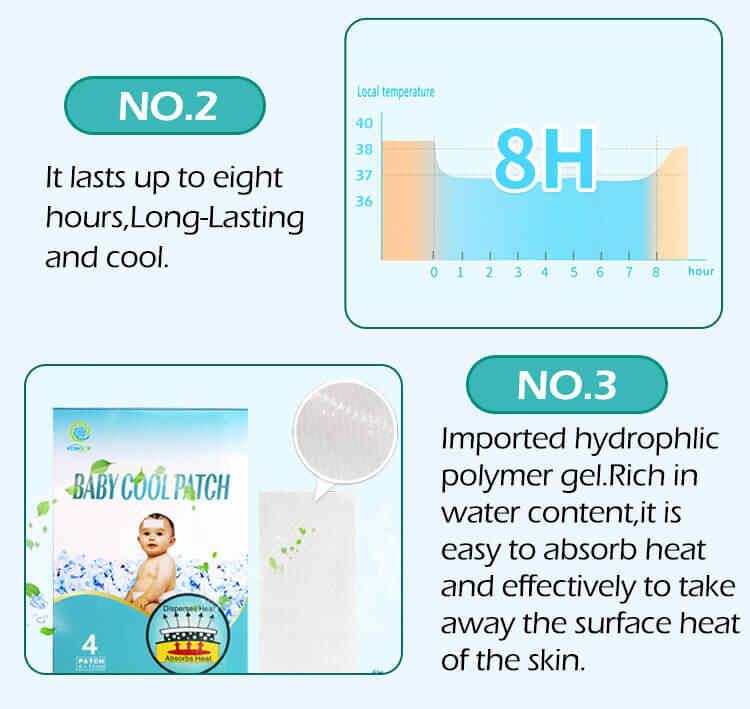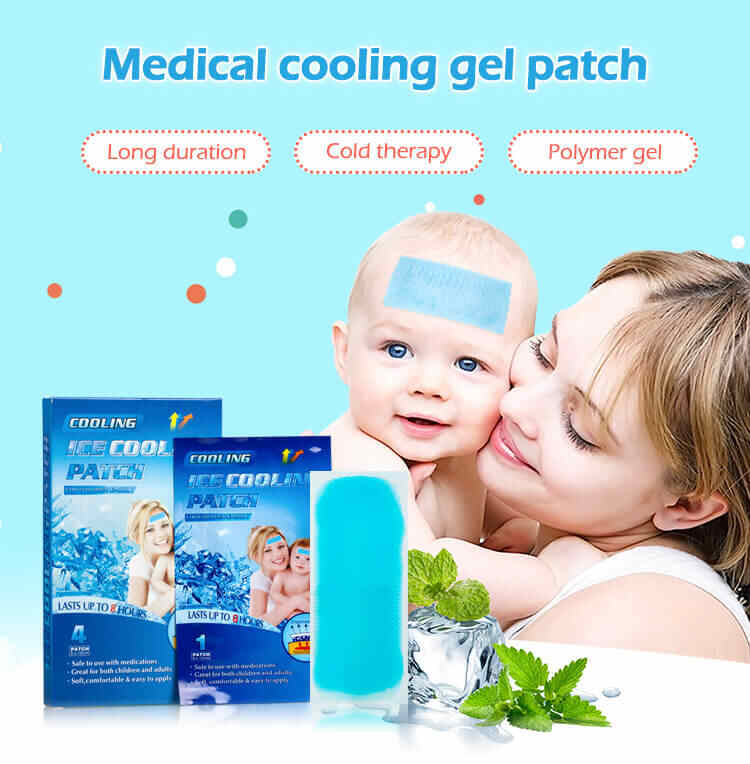What Types of Materials Can Be Used in Custom Fever Cooling Patches?
In the fast-evolving healthcare and wellness market, fever cooling patches have gained wide acceptance for their ease of use, portability, and effectiveness in managing mild fevers and heat-related discomfort. However, not all cooling patches are created equal. The materials used in their production—ranging from hydrogel components to back films and active ingredients—play a critical role in performance, safety, and user satisfaction.
For businesses looking to enter this market or upgrade their product line, understanding the materials used in custom fever cooling patches is essential. Whether you are working with a fever cooling patch manufacturer, engaging a fever cooling patch OEM, or sourcing from a fever cooling patch supplier, material selection directly impacts product quality and brand competitiveness.
In this article, we’ll explore the different materials used in custom fever cooling patches, how they influence product function, and what you need to consider when developing your own private label fever cooling patch.

Why Material Choice Matters in Fever Cooling Patches
Every layer of a fever cooling patch serves a specific purpose:
Hydrogel Matrix – Responsible for the cooling effect and active ingredient delivery.
Back Film – Prevents water loss and ensures structural integrity.
Release Liner – Protects the patch before application.
Adhesives – Must be skin-friendly and effective without causing irritation.
Using high-quality, functional, and skin-safe materials ensures:
Effective and consistent cooling performance
Skin safety for all age groups, including infants
Enhanced comfort and wearability
Product longevity and shelf stability
Let’s now break down the materials typically used in each component and how they can be customized through your fever cooling patch OEM.
1. Hydrogel Layer: The Heart of the Cooling Patch
The hydrogel is the most crucial element in any fever cooling patch. It stores water and active cooling agents, and when applied to the skin, it provides an evaporative cooling effect.
Common Hydrogel Materials:
✅ Water (H2O)
The main component providing the cooling sensation.
Must be purified or deionized for safety.
✅ Glycerin
A humectant that retains moisture and enhances the cooling duration.
Often used in custom fever cooling patch formulations for better hydration.
✅ Polyacrylic Acid / Carbomer
Acts as a thickening agent and helps form the hydrogel structure.
Offers flexibility and stretchability.
✅ Natural Polymers (Optional)
Includes xanthan gum, guar gum, and alginate.
Ideal for organic or eco-friendly fever cooling patch formulas.
✅ Menthol or Cooling Agents
Provides the “cold” sensation. Levels can be adjusted for children or sensitive skin.
Natural mint or synthetic menthol variants available depending on your branding.
✅ Botanical Additives (Optional)
Chamomile, aloe vera, lavender extract, or green tea are often included in private label fever cooling patch products to offer calming or anti-inflammatory benefits.
When developing a custom fever cooling patch, you can tailor the hydrogel formula to control cooling intensity, duration, skin feel, and scent.
2. Backing Film: Durability and Protection
The back film is the layer that remains on the outside while the patch is worn. It needs to be durable, flexible, and impermeable to water loss.
Backing Film Materials:
✅ Non-Woven Fabric (Polyester or Polypropylene)
Lightweight and breathable.
Common in mass-market fever cooling patch OEM products.
✅ PE (Polyethylene) Film
Offers waterproofing and excellent flexibility.
Cost-effective and widely used.
✅ PU (Polyurethane) Film
Highly stretchable and breathable.
Preferred for premium private label fever cooling patches due to better comfort and skin fit.
✅ Biodegradable Films (Eco-Friendly Option)
Made from corn starch or polylactic acid (PLA).
Increasingly popular with environmentally conscious brands.
Choosing the right back film affects comfort, breathability, and sustainability—factors critical to brand perception and user satisfaction.
3. Release Liner: Protection Before Use
The release liner protects the hydrogel before application. It must be easy to peel and not react with the hydrogel.
Typical Materials:
✅ Silicon-Coated Paper
Low-cost, effective, and commonly used by many fever cooling patch manufacturers.
✅ PET Film (Polyethylene Terephthalate)
Offers excellent stability and is often used for medical-grade custom fever cooling patches.
✅ Eco-Friendly Liners
Paper-based options with natural wax or water-based coatings are now available for sustainable product lines.
4. Adhesives: Gentle Yet Effective
While hydrogel-based patches don’t always require a strong adhesive, some formulations—especially those intended for mobile use—benefit from added adhesion.
Types of Adhesives:
✅ Acrylic Adhesives
Hypoallergenic and skin-friendly.
Long-lasting adhesion and widely approved for use in medical patches.
✅ Silicone-Based Adhesives
Ideal for sensitive skin, especially in children or the elderly.
Leaves no residue and is gentle upon removal.
✅ Natural Adhesives
Some custom fever cooling patch OEMs use plant-based adhesive systems for natural/organic lines.
5. Optional Enhancements for Differentiation
Fragrance Layers or Scent Infusions
Infusing lavender, eucalyptus, or citrus oils into the hydrogel or release liner can provide a sensory experience.
Helps create a unique selling point for your private label fever cooling patch.
Color and Shape Customization
Colorants can be added to distinguish product lines.
Shapes like stars, animals, or rounded corners improve child-friendliness and brand appeal.
Antibacterial or Antiviral Additives
Can be added for healthcare or hospital-use patches.
How Fever Cooling Patch OEM Partners Enable Customization
A reliable fever cooling patch OEM provides technical and material flexibility to develop a product that aligns with your brand’s identity. The best OEMs offer:
Access to medical-grade and cosmetic-grade materials
Laboratory formulation testing and certification support
Material performance testing (cooling time, adhesion, evaporation rate)
Regulatory assistance for different international markets
Working with an experienced fever cooling patch manufacturer ensures:
All components meet health and safety standards
The patch functions consistently across batches
Raw materials are ethically and sustainably sourced (if required)
Choosing the Right Fever Cooling Patch Supplier: Key Considerations
Before selecting a supplier for your custom fever cooling patch, evaluate:
| Criteria | What to Look For |
|---|---|
| Material Options | Variety of hydrogel bases, back films, and release liners |
| R&D Capability | Can they help develop unique formulations from scratch? |
| Compliance & Certifications | GMP, ISO, CE, FDA registration |
| MOQ Flexibility | Small test orders before large-scale production |
| Packaging Solutions | Eco-friendly, resealable, travel-size packaging options |
| Skin Safety Testing | Patch testing, dermatological evaluations, hypoallergenic tests |
A trustworthy fever cooling patch supplier will not only meet production needs but also help you innovate.
Use Cases for Material Customization
| Market Segment | Recommended Material Features |
|---|---|
| Pediatric (Infants/Kids) | Ultra-gentle hydrogel, PU backing, no menthol |
| Sports/Recovery | Long-duration hydrogel, breathable film, menthol + camphor |
| Hospital/Clinical | Sterile materials, antibacterial hydrogel, strong adhesion |
| Organic/Green Brand | Plant-based hydrogel, biodegradable film, natural adhesives |
| Luxury Wellness Brand | Scented variants, elegant packaging, skin-nourishing additives |
Final Thoughts: Your Materials Define Your Brand
When you choose to develop a custom fever cooling patch, you’re not just selecting a product—you’re crafting a brand experience. Each material, from hydrogel composition to backing film and adhesives, plays a pivotal role in defining how customers perceive and use your product.
By partnering with a qualified fever cooling patch OEM or private label fever cooling patch manufacturer, you gain access to advanced material options, expert guidance, and flexible production capabilities. Whether you're targeting the pediatric market, eco-conscious consumers, or premium healthcare segments, material customization will help you build a product that truly resonates with your target audience.
Related Questions & Short Answers
1. Can I choose eco-friendly materials for my custom fever cooling patch?
Yes. Many fever cooling patch suppliers now offer biodegradable films, plant-based hydrogels, and natural adhesives.
2. Which material is safest for children’s fever cooling patches?
PU film with hypoallergenic, menthol-free hydrogel is recommended for pediatric use.
3. What is the best material for extended cooling duration?
Hydrogels with high glycerin and water retention paired with breathable back films provide longer cooling effects.
4. Do materials affect patch shelf life?
Absolutely. Quality of materials (especially hydrogel and back film) influences water retention, evaporation rate, and storage stability.
5. Can a fever cooling patch manufacturer help with ingredient testing and certification?
Yes. Leading OEMs provide lab testing, compliance documentation, and assistance with FDA/CE approval.






